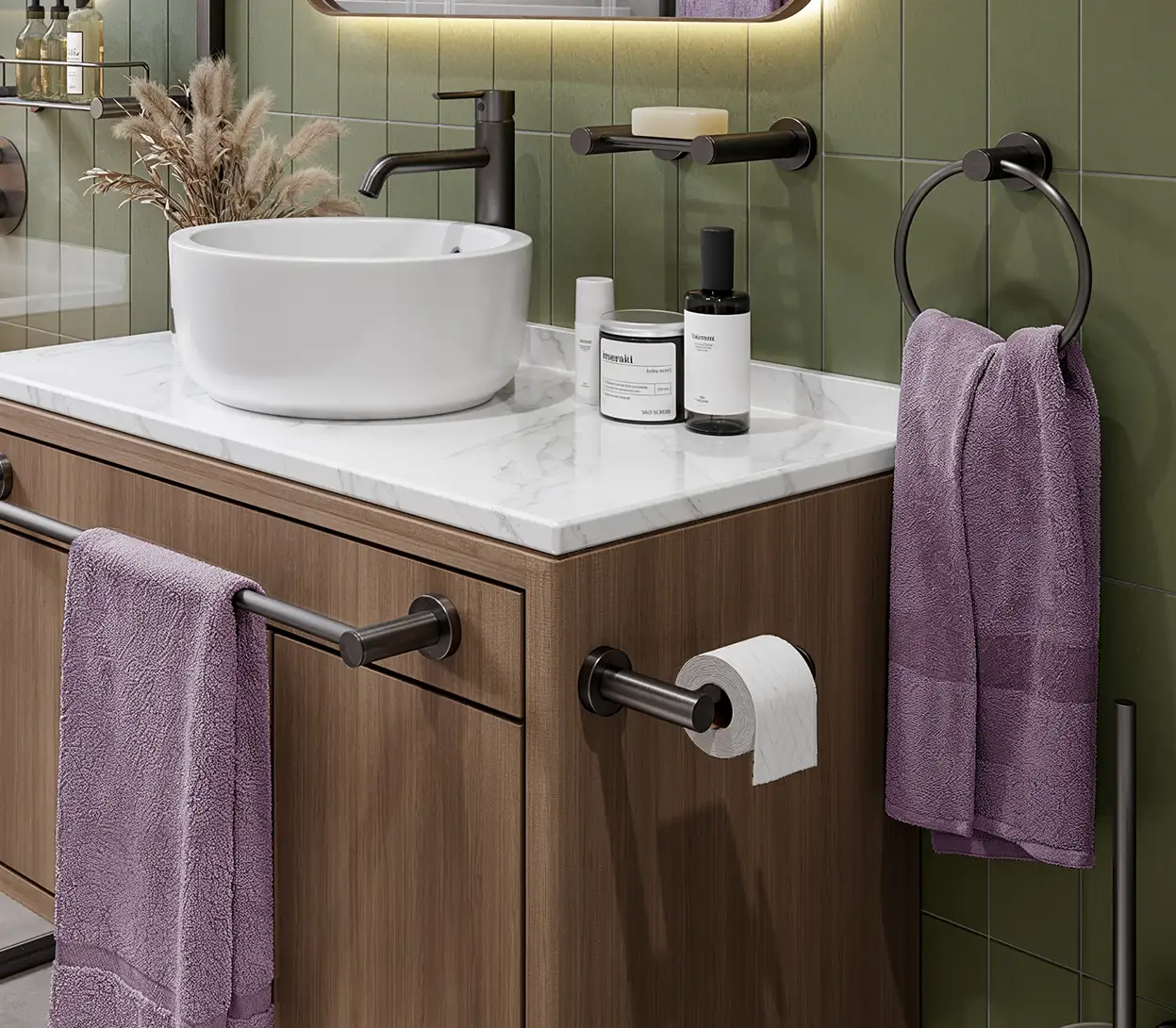Are you ready to transform your bathroom experience? Join us as we dive into the world of heated towel racks and towel warmers, comparing their features and benefits. In this post, we’ll help you understand the key differences between these two popular bathroom accessories so you can make the best choice for your home. Let’s get started!
Key Takeaways
- Design and Installation: Heated towel racks are typically wall-mounted and require professional installation, while towel warmers are standalone, portable units that offer a plug-and-play setup.
- Functionality and Energy Efficiency: Heated towel racks provide both drying and warming capabilities and are generally more energy-efficient. Towel warmers, on the other hand, primarily focus on warming dry towels but consume more energy.
- Temperature Control and Timing: Heated towel racks often come with advanced features for rapid heating and customizable temperature settings, while towel warmers take longer to heat up and require more planning for efficient use.
What we’ll cover
- What is a heated towel rack?
- What is a towel warmer?
- Differences between heated towel racks & towel warmers
- Design and installation
- Functionality and purpose
- Usage and maintenance
- Energy efficiency and consumption
- Temperature control and timing
What is a heated towel rack?
Heated towel racks, also known as heated towel rails, are bathroom fixtures designed to keep your towels dry and warm, providing you with a cozy embrace after a relaxing shower or bath. Typically wall-mounted, these racks come in various styles and finishes, allowing you to choose the perfect one to complement your bathroom décor. Not only do heated towel racks dry your towels efficiently, they also add a touch of luxury and sophistication to your space.
What is a towel warmer?
On the other hand, towel warmers are stand-alone appliances, often resembling a bucket, which focus primarily on warming your towels. Unlike a heated towel rack, towel warmers do not dry your towels but provide an extra layer of comfort for those chilly mornings or evenings.
Differences between heated towel racks & towel warmers
As we delve into the nuances of these two bathroom accessories, we’ll discuss their differences in design, functionality, energy efficiency, and more to help you determine which one best suits your needs and preferences. Stay tuned as we examine each aspect in detail! Explore beautiful heated towel racks for your bathroom in the United States, South Africa and Australia.

1. Design and installation
When it comes to design, heated towel racks and towel warmers showcase their unique characteristics.
Design and installation of heated towel racks
A heated towel rack is typically wall-mounted, offering a sleek and space-saving solution for your bathroom. They come in various sizes, styles, and finishes to complement any interior design. Installation-wise, heated towel racks demand a bit of effort as they need to be securely attached to the wall, often requiring professional assistance. This process may involve drilling holes, connecting electrical wiring, and mounting the rack in the desired location. Once installed, heated towel racks provide a seamless and elegant appearance. While wall-mounted heated towel racks are a popular choice, it’s worth noting that there are also freestanding models available. Freestanding heated towel racks offer mobility and require no installation. However, they occupy more floor space and may not match the sleek aesthetics of wall-mounted versions.
Design and installation of electric towel warmers
Conversely, freestanding, electric towel warmers provide more flexibility in terms of placement as they don’t require wall installation. These portable units can easily be moved around and positioned near a power outlet, making them a convenient choice for those who desire adaptability. Most towel warmers are generally plug-and-play, meaning you can simply plug them into an electrical outlet and start enjoying warm towels without any complex installation process. This user-friendly aspect makes towel warmers an attractive option for those who prefer a hassle-free setup.
2. Functionality and purpose
When making a decision between buying a heated towel rack or a towel warmer, make sure you understand the differences in their functionality and purpose. Heated towel racks offer a combination of drying and warming capabilities, making them a practical and efficient choice for most households. Towel warmers, while delivering the indulgence of warm towels, lack the drying functionality, making them a more luxurious option for those who prioritize comfort over practicality. When deciding between the two, consider your specific needs and preferences in terms of functionality and purpose.
Function and purpose of a heated towel rack
Heated towel racks work using an electric heating element to warm the metal bars on which towels are hung. This process not only provides the comfort of dry towels, reducing the chances of bacterial growth and dampness but also adds a touch of warmth. Ultimately, heated towel racks serve one main purpose: drying your towels to maintain a hygienic bathroom environment while additionally providing the comfort of warm towels.
Function and purpose of a towel warmer
Towel warmers, on the other hand, focus only on warming your towels. They usually come in the form of a standalone appliance, often shaped like a bucket or container, that uses a heating element to create a warm and cozy interior space. Towels placed inside the towel warmer become toasty and comfortable but must already be dry, as these devices are not designed to dry damp towels. Thus, the main purpose of a towel warmer is to provide a touch of luxury by offering warm towels for use after bathing or showering.

Interested in a high-quality heated rack? Explore the NATURAL 5 Bar 20-inch Straight Heated Towel Rack
3. Usage and maintenance
Understanding the proper usage and maintenance of heated towel racks and towel warmers is crucial for maximizing their efficiency and benefits. By following these usage and maintenance guidelines, you can enjoy the full benefits of your heated towel rack or towel warmer.
How to use a heated towel rack
Proper towel placement will help you use your towel rack efficiently and maximize exposure to the warm air. This ensures faster and more effective drying. Fold your towel twice, length-wise, to create four layers, hang it over a single rung of the heated rack, and avoid weaving your towels across the rack’s bars. For heated towel racks with programmable features, you can further optimize their efficiency by setting the device to turn on and off at specific times. This can help conserve energy and ensure that your towels are warm and dry when you need them most.
How to use a towel warmer
In contrast, using a towel warmer requires a few more steps. Most importantly, you must ensure your towels are dry before placing them in the towel warmer. Place your dry towels inside the warmer, close the door or lid, and turn on the device. Wait for the recommended time (usually around 20 – 50 minutes) before removing the warm towels for use. Remember that towel warmers are not designed to dry damp towels, so only place completely dry towels inside the appliance.
4. Energy efficiency and consumption
When considering heated towel racks and towel warmers, it’s essential to understand the differences in energy efficiency and consumption between the two options. Lastly, energy-efficient features like programmable timers and thermostats can help optimize the energy consumption of both heated towel racks and towel warmers. By setting the device to operate only when needed, you can reduce energy usage while still enjoying the comfort of warm, dry towels. By understanding the energy efficiency and consumption differences between heated towel racks and towel warmers, you can make a more informed decision about which option best suits you.
How energy efficient is a heated towel rack?
Heated towel racks are generally more energy-efficient than towel warmers, mainly due to their design and the technology they employ. For instance, Bathroom Butler heated towel racks use Dry Element Technology, which consumes on average between 40 to 180 Watts of electricity, depending on the size and number of bars. This translates to lower energy consumption and reduced utility bills in the long run.
How much energy do towel warmers use?
Towel warmers often use more electricity than heated towel rails, consuming around 500 Watts on average. While they provide the convenience of quickly warming your towels, the increased energy consumption can lead to higher electricity bills, especially if you use the device daily. It’s essential to weigh the benefits of a warm towel against the additional energy costs when choosing between these two options.
5. Temperature control and timing
Temperature adjustment and timing are important factors to consider when comparing a heated towel rack and towel warmer. When choosing between a heated towel rack and a towel warmer, consider the convenience and efficiency offered by the temperature adjustment and timing features. A heated towel rack with advanced features like rapid heating and customizable temperature settings can provide a more user-friendly and energy-efficient experience, while a towel warmer may require more planning and attention to ensure safe and efficient use.
Temperature control and timing for heated towel rails
For example, Bathroom Butler heated towel racks are equipped with Dry Element Technology (DET) to provide quick and efficient heating, reaching optimal working temperatures in just 15 minutes. Additionally, these heated towel racks come with advanced features like Personal Temperature Selection (PTS) Switches which allow for customizable temperature settings, energy consumption management and timed operation. And to add to this impressive arsenal all of these racks can be connected to a Wi-Fi-enabled switch, allowing you to manage your rack remotely.
Temperature control and timing for towel warmers
Towel warmers, on the other hand, typically take longer to reach their desired temperature, sometimes taking up to 20-50 minutes or more. This means you need to plan your towel-warming sessions in advance to ensure you have warm towels when you need them. As for safety, it is essential not to leave a towel warmer on for an extended period. Generally, it is recommended to turn off the towel warmer when it is not in use, as continuous operation can lead to excessive energy consumption and potential safety hazards. Explore our collection of heated towel racks with PTSelect switches in the United States, South Africa and Australia.

Final thoughts on the differences between towel warmers and heated towel racks
When it comes to deciding between a towel warmer and a heated towel rack or heated towel rail, budget and price factors are essential to keep in mind. While towel warmers may initially seem more affordable, heated towel racks provide more long-term value due to their energy efficiency and multi-functionality.
Remember to weigh both the short-term and long-term costs when making your decision. As you consider your options, take into account the design, installation, functionality, usage, maintenance, energy efficiency, temperature control, and timing of each appliance. Understanding these differences will help you make an informed decision and select the right option for your specific needs and preferences.
Keep in mind the benefits of each product, such as the aesthetic appeal and dual purpose of heated towel racks, or the simplicity and lower upfront cost of towel warmers. To explore a wide range of high-quality heated rails that offer both style and functionality, check out Bathroom Butler’s collection of heated towel racks. Discover the perfect solution for your bathroom and experience the luxury of warm, dry towels every day.




